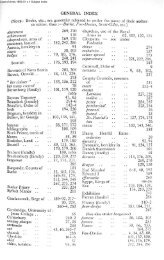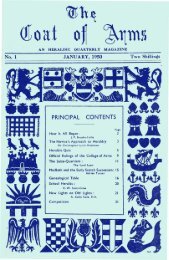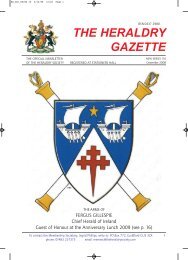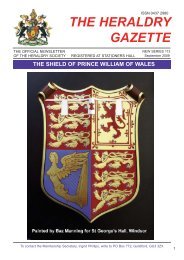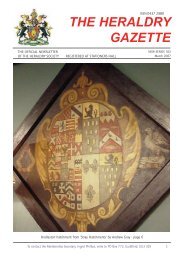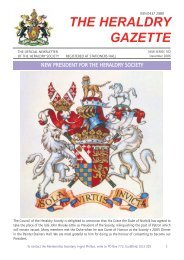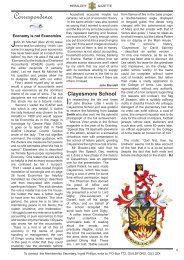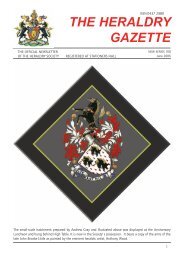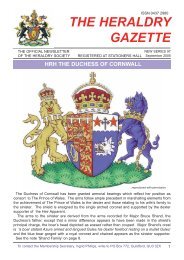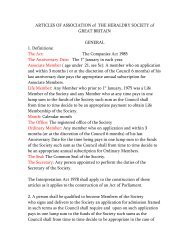Mar-06 Issue - The Heraldry Society
Mar-06 Issue - The Heraldry Society
Mar-06 Issue - The Heraldry Society
Create successful ePaper yourself
Turn your PDF publications into a flip-book with our unique Google optimized e-Paper software.
WILLIAM MAVING GARDNER - PART TWO<br />
After the war Gardner and<br />
his family moved to Rye. As he<br />
began to make up in<br />
reputation and professional<br />
experience delayed by his war<br />
service, he was commissioned<br />
by His Majesty King George VI<br />
to produce a Roll of Honour for<br />
the Household Cavalry and<br />
received the first commission<br />
of many from the Royal Mint.<br />
He was elected a Fellow of the<br />
Royal <strong>Society</strong> of Arts in 1955<br />
and served on the jury of its<br />
industrial design bursary<br />
scheme. He also designed the<br />
definitive Jersey stamp in<br />
1958 and a tercentenary<br />
stained glass window for the<br />
Royal <strong>Society</strong> two years later.<br />
William Gardner was the first<br />
calligrapher to be awarded a<br />
Churchill Travelling<br />
Scholarship. He was visiting<br />
professor at Colorado State<br />
University and used his<br />
Scholarship to research arts<br />
and crafts in America,<br />
Polynesia, New Zealand,<br />
Australia and Nepal. He was a<br />
visiting lecturer at three<br />
schools of art and in due<br />
course, was invited by John<br />
Enderby, the principal, to<br />
return to Hampstead Garden<br />
Suburb to run a weekly class<br />
in calligraphy and lettering. It<br />
was here that the author came<br />
into personal contact with him<br />
as a mature student seeking<br />
specialist tuition in heraldic<br />
design.<br />
As a teacher he was<br />
methodical, precise and slow<br />
moving. His philosophy<br />
regarding the study of lettering<br />
in general and calligraphy in<br />
particular was to ensure that<br />
students received a sound<br />
basic training in letterforms,<br />
spacing and layout. First term<br />
students were set to drawing<br />
traditional roman capital<br />
letters until they were<br />
thoroughly familiar with them.<br />
This might well occupy the<br />
whole of their first term or<br />
even longer, but they were not<br />
encouraged to start making<br />
letters with a chisel edged pen<br />
until either he or they<br />
considered that they were<br />
ready to do so.<br />
This approach was two<br />
edged in that if a student was<br />
unable or unwilling to submit<br />
to the necessary discipline<br />
involved for long enough to<br />
achieve the desired result, it<br />
was unlikely that they would<br />
become calligraphers of an<br />
acceptable standard which<br />
was at that time an 'A' Level in<br />
Art. It in effect weeded out the<br />
wheat from the chaff.<br />
Nevertheless, his students<br />
had the greatest admiration<br />
for him and judging from the<br />
number who returned year<br />
after year, such a regime did<br />
not discourage many. He set<br />
the example of developing<br />
patience and concentration<br />
both in his teaching and in his<br />
professional work. That he<br />
was always willing to<br />
experiment with methods and<br />
textures in whatever medium<br />
came to hand, he produced a<br />
roundel containing the arms of<br />
Beaufort as a lino cut, which<br />
he then gilded and painted. It<br />
came into the author's<br />
possession quite by chance<br />
and when he mentioned it to<br />
Gardner, he could not<br />
remember ever having done it.<br />
He was not enamoured of<br />
motor cars and never drove or<br />
owned one, travelling<br />
everywhere by bus and train.<br />
This increased his work load<br />
considerably, but he put the<br />
hours of travelling to good use<br />
by reading and speculation.<br />
He was a member of the<br />
Royal Mint panel of artists for<br />
over thirty years, He designed<br />
and engraved the whole or<br />
part of the coinage for Jordan,<br />
Cyprus, Algeria, New Zealand,<br />
Guyana, the Dominican<br />
Republic, Sri Lanka, the<br />
Falkland Islands and of course<br />
<strong>The</strong> deadline for contributions to the next Gazette is 1st May 3



